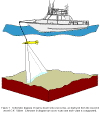
Geophysical Surveys (cont.)Side-Scan Sonar SurveysObjectives and Accomplishments
Through shipboard and postprocessing, the return signal is filtered for noise and corrected for spatial and geometric variation. Signal strength is represented by pixel intensity, and adjacent returns are geographically referenced into a mosaic to produce a two-dimensional image, similar to a photograph, of the sea floor. This spatial representation of the sea floor is a useful tool for identifying small-scale geomorphologic features and sediment texture distribution. Manmade features such as dredge pits and dump sites are also commonly of appropriate dimension to be readily imaged by this technique. Like HRSP, side-scan sonar image quality and resolution are dependent on a number of factors, including sea state, altitude of the tow fish above the bottom, noise (associated with the tow vessel, other vessels, or the water column) and navigation/bathymetric resolution. Towing altitude is a major factor in this study. The areas surveyed in this project are typically not deep enough for an adequate side- scan swath width. Altitudes should be roughly a tenth of swath; for a 100- m swath the tow fish should be at an altitude of 10 m above the sea floor. This depth would exclude most of the Lake Pontchartrain Basin. Thus for this study, side-scan sonar surveys were restricted primarily to the deeper approaches to Lake Pontchartrain (Rigolets and Chef Menteur) and to the dredge pits along the south shore, with water depths exceeding 18 m. In 1998, a survey of 15 lines 100 m apart was conducted concurrently with HRSP over a dredge pit identified from bathymetric surveys conducted the same year. The dredge pit is located just northeast of the Lakefront Airport, southern Lake Pontchartrain (see fig. 2). Another dredge pit located approximately 0.5 km from South Point, eastern Lake Pontchartrain, was surveyed with 13 lines 100 m apart. A third survey covered the area just west of Lakefront Airport over the Inner Harbor Canal and dredge pits associated with the south shore. This survey included a grid of 17 lines 100 m apart and an additional six lines running under the Seabrook bridge into the Inner Harbor Canal. The side-scan sonar surveys were conducted in response to the identification of the dredge pits and their potential as recent sediment traps, an undisturbed receptacle for contaminants associated with development along the south shore. In conjunction with bathymetry surveys acquired earlier and discussed next, the surveys were intended to delineate the dimensions of the dredge pits and to identify any internal structure to the sediments in and about the depressions. Methods The side-scan sonar system includes an EG&G towfish running at 100 kHz, controlled by a SEAMAP signal processor. The towfish is deployed approximately 5 ft below the surface with a transducer angle of about 10 degrees. Boat speed is maintained at about 4 knots. Acquisition software was the Elics Delph sonar system, running in real time on a Kontron Electronics IP Lite laptop computer. A 100-m swath was being collected, with the digital data backed up on removable 1-gigabyte hard disks. Navigation data were collected every 2 s using a PLGR (Rockwell) GPS receiver with Geolink mapping software. Bathymetry was collected using one E Sound 103 fathometer at 200 kHz and Fugawi acquisition software.
|
|||||||||||||||
